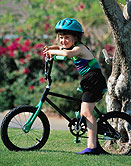
TUESDAY, Nov. 30 (HealthDay News) — Primary school children cannot accurately estimate the speed of approaching vehicles moving faster than 20 miles per hour, finds a new study.
“This is not a matter of children not paying attention, but a problem related to low-level visual detection mechanisms,” John Wann, lead researcher and a professor in the department of psychology at Royal Holloway College, University of London, said in a university news release.
“So even when children are paying very close attention, they may fail to detect a fast-approaching vehicle,” Wann warned.
He and his colleagues assessed the perceptual acuity of more than 100 primary school children and calculated their ability to reliably judge the speed of an approaching vehicle. While adult pedestrians can make accurate estimates of vehicle speeds up to 50 mph, the children’s judgments were unreliable when the speed was above 20 mph and the vehicle was five seconds away.
“These findings provide strong evidence that children may make risky crossing judgments when vehicles are traveling at 30 or 40 mph,” Wann said.
“In addition, the vehicles that they are more likely to step in front of are the faster vehicles that are more likely to result in a fatality,” he added.
“Traveling one mile through a residential area at 20 mph versus 30 mph will only add 60 seconds to your journey time — we encourage drivers to take a minute and save a child’s life,” Wann said.
The study findings were released online Nov. 23 in advance of publication in an upcoming print issue of the journal Psychological Science.
More information
Safe Kids offers pedestrian safety tips.

